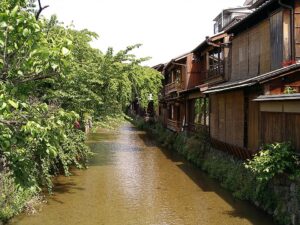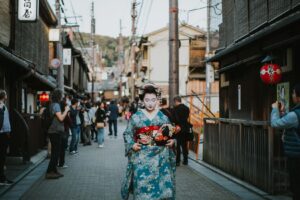Chapter Scope: This chapter shows how popular guides for Japanese readers introduce Kyoto’s five hanamachi (flower districts), explaining their history, the community’s values, the teahouse system, and the gendered roles of women in leadership, older men as the typical clients, and “salon masculinity.”
Map of the five Kyoto hanamachi, see https://janbardsley.web.unc.edu/maiko-masquerade/kyoto-hanamachi-map/
This page includes reading questions, writing exercises, and discussion activities about tourism for this chapter:
- “The Maiko’s Hanamachi Home”– chapter questions
- “Touring the Hanamachi”–group activity, online resources
- “What Makes a Tourist Site?”–group activity & discussion
For instructors: This topic works well for two class sessions: the first can focus on the hanamachi as presented to Japanese, and online, to international tourists; the second can open broad discussion of tourism, sites, and travel experience.
READING QUESTIONS FOR “THE MAIKO’S HANAMACHI HOME”
The Hanamachi Writers
Who are the authors of guides to the hanamachi?
How did they come to this work?
What kinds of books do they write?
The Hanamachi Community
What stands out to you about these communities as physical spaces?
What values do the communities promote?
How would you characterize the shifts in their commercial viability?
The Ochaya: Teahouse System
Who is the okami-san? What kinds of work does she do? Who takes on this role?
What kind of space is the ochaya?
What is an ozashiki? What kinds of activities take place?
The Clients
We find examples of boorish and suave clients in fiction and guides on the hanamachi. What kind of “salon masculinity” wins favor with women working in the teahouse system?
What is the No First-Timer Rule? How do the teahouse managers defend its importance?
What obligations does the teahouse client have?
When do women enter the picture as clients?
Japanese tradition
How do guides present the hanamachi as a respected site of Japanese tradition?
How do roles for women in the hanamachi blend familiar notions of femininity and contemporary ideals of empowerment and women’s leadership?
Stories of the hanamachi of old can inspire nostalgia. What about this romantic hanamachi past is appealing?
Overall reading questions
What are the three key ideas you’ve learned from this chapter?
What information or analysis is missing? How do these gaps suggest future research?Are there tourist spaces in other countries similar to the hanamachi?
Writing exercises (250 words each):
Advising: You’re working at a trading company. A team of salespeople will be traveling to Japan next month. Their Kyoto colleagues have invited them to attend an ozashiki, but they have no idea what that is. Write a concise memo to explain the basics. What is the information that they most need to know?
Interviewing: Imagine that you have a chance to interview the okami-san of a teahouse. Prepare eight questions. Explain what you hope to learn from the interview.
DISCUSSION ACTIVITIES
“TOURING THE HANAMACHI”: GROUP ACTIVITY
Divide into small groups. Use chapter information and online sources to learn about the hanamachi and develop your own guided tour. You can find many photographs for each hanamachi and articles describing public ceremonies and dance productions involving their maiko and geiko. These will help you visualize and distinguish the neighborhoods. Evaluate your online sources as you search: Who or what organization is the author? How recent is the post? How do they characterize the hanamachi? In Japanese, the Kyoto Traditional Musical Art Foundation’s website directs viewers to the homepages for each of the hanamachi: https://www.ookinizaidan.com/kagai/.
Your group might consider:
Mapping your hanamachi
Finding the notable landmarks
Finding interesting architectural features
Finding out about its major dance productions
Intriguing aspects of its history
Shops and cafes in the hanamachi
Put your key ideas and images into a group PowerPoint
Present to the class.
Active Listening: As you listen to the “tour guide” presentations, consider how the guides present the hanamachi as a place worthy of a visit. What role do images play in conveying enthusiasm for a tourist place? When you consider traveling abroad, what sorts of images and stories pique your curiosity? What do you hope to experience in travel that you won’t find at home?
“WHAT MAKES A TOURIST SITE?”: GROUP ACTIVITY
Questions:
Tourist, once a positive term, now has negative connotations. Why does the tourist get a bad reputation?
Name some globally famous sites. What makes them a tourist attraction?
What is the appeal of going “off the beaten path?”
Travel takes time, money, inconvenience, even risk. Why travel when you can watch tourist movies at home and make new foods from a cookbook?
Group Exercise
Imagine guiding students from abroad to your campus one afternoon.
Name three sites that you would like them to visit. Why would you choose these?
Discussing your group’s ideas with the class, you might also think about the campus tours commonly given to prospective students. What places do they choose? What stories do they tell?
Viewing Exercise:
Watch “Far from Yokohama,” a segment in the film Mystery Train (1989) by Jim Jarmusch, about two Japanese teens visiting Memphis, home of their favorite music legends. What does this segment say about motivations for travel, the sense of having “arrived,” and the idea of the souvenir?
How would you apply these ideas of tourism and creating tourist spaces to promotions of Kyoto’s hanamachi?
Suggestions for Further Reading and Viewing
- For more on Kyoto tourism, see Jennifer Prough’s forthcoming book, Revisiting Kyoto: Heritage Tourism in Contemporary Kyoto. Honolulu: University
of Hawai‘i Press. Prough has a fascinating chapter on the popular new practice of tourists renting kimono and strolling in costume in Kyoto. - For a comic example of a boorish First-Timer, see the 2007 Japanese movie Maiko Haaaan! The unlucky man bursts into song about the sorrow of Mr. First-Timer (Ichigen-san). A DVD subtitled in English is available.
- For historical view of boorish and suave men in the pleasure quarters, see “The Age of the Dandy: The Flowering of Yoshiwara Arts,” Ch. 5 in Cecilia Segawa Seigle, Yoshiwara: The Glittering World of the Japanese Courtesan(University of Hawai’i Press, 1993), 129-168. We learn about the tsū, a “paragon of sophistication,” and the hanka-tsū, the “half-baked” would-be dandy, and the comic genre (sharebon) that delighted readers with (mis) adventures in the pleasure quarters. To delve further into this literature, see “Early Modern Japan,” and “Sharebon: Roots of Wit and Fashion” in ed. Haruo Shirane and James Brandon, Early Modern Japanese Literature, An Anthology by , Columbia University Press, 2002), 1-19; 310-319. Writing exercise for these readings: “Dos and Don’ts” columns are funny features in magazines. Write a short comic piece of the Five Dos & Don’ts for the Edo teahouse client (150 words).
- For more on 2000s manners guides for older Japanese men, see Jan Bardsley’s chapter, “The Oyaji Gets a Makeover: Guides for Japanese Salarymen in the New Millennium,” in Manners and Mischief: Gender, Power, and Etiquette in Japan, ed. Jan Bardsley and Laura Miller (Berkeley: University of California Press, 2011), 114–35.
- For a broader view of new forms of masculinity in contemporary Japan, see Cool Japanese Men: Studying New Masculinities at Cambridge, ed. Brigitte Steger and Angelika Koch ( LIT Verlag, 2017).
- For more on the etiquette performed by geiko, maiko, and their clients at ozashiki, see “The Perfect Woman: Geisha, Etiquette, and the World of Japanese Traditional Arts,” in Manners and Mischief, 67–79.

